Male Bamboo, Calcutta stricta
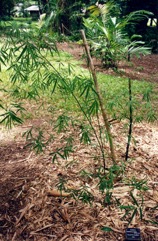
A tropical plant. t grows in tropical and subtropical places. The best annual temperature is between 20-30°C. It can stand temperatures down to -5°C and up to 45°C. A rainfall between 1000-3000 mm is best. It can tolerate drought and does best with lower humidity. It can grow up to 1,200 m altitude. It does best on sandy soils with a pH of 5.5-7.5. In the Cairns Botanical Gardens. I
Also known as:
An-kuang, Bambu besi, Bambu batu, Bans Ka Ban, Bans kaban, Bans khurd, Basa, Bhariyel, Bidiru, Biru mad, Buloh batu, Calcutta bamboo, Delea bance, Heedi, Hmyin-wa, Iudo, Kal, Kali musali, Kalmungil, Karai bans, Karail, Kavil, Keltha, Kiri bidiru, Lathi bans, Manwal, Mungil, Myinwa, Nakor vans, Nakur bans, Narbans, Phai-sang, Phai sang dam, Ranj, S'ang, Sadanapa veduru, Salia bhanso, Salimbo bhanso, Solid bamboo, Tama bans, Vansha, Veddur, Veduru, Velu
Synonyms
- Bambos stricta Roxb.
- Bambusa stricta (Roxb.) Roxb.
Edible Portion
- Seeds, Leaves, Shoots, Cereal, Manna, Rhizome, Root
Where does Male Bamboo grow?
Found in: Africa, Asia, Australia, Bangladesh, Bhutan, Central America, China, Cuba, East Africa, Ghana, Guam, Himalayas, India, Indochina, Indonesia, Laos, Malaysia, Myanmar, Nepal, Northeastern India, NW India, Pacific, Pakistan, Philippines, Puerto Rico, SE Asia, Sikkim, Sri Lanka, Taiwan, Thailand, United States, Vietnam, West Africa, Zimbabwe
Notes: There are about 29 Dendrocalamus species. Chemical composition 100 g edible portion. Shoots: Water 90 g, Protein 2.9 g, Fat 0.3 g, carbohydrate 2 g, fibre 1 g, ash 1 g, Ca 15 mg, Fe 0.6 mg, P 46 mg, Vit A 133 IU, Vit C 0.2 mg.
Status: It is a cultivated food plant. Shoots are sold in markets.
Growing Male Bamboo, Calcutta stricta
Cultivation: Plants are grown from seeds or by splitting the rhizome. It can also be grown with difficulty from culm or stem cuttings and by tissue culture. Seed need to be planted fresh. They lose their viability is 3 months. Seed once dried and stored in cool conditions can be kept for 3 years.
Edible Uses: Young shoots are cooked as a vegetable or pickled. The seeds are also roasted and eaten. There is also an edible manna that develops on this plant. The roots are pounded into a powder.
Production: They take 6-13 years to produce a mature clump. The new rhizomes bend downwards before curving up to produce new shoots. Clumps deepen and widen. Up to 20 new culms can be produced each year from a large clump. Up to 200 can be produced from very large clumps. Only a few culms may die after flowering and not the whole clump. The time till flowering can be 20-65 years.
Nutrition Info
per 100g edible portion| Edible Part | Energy (kcal) | Protein (g) | Iron (mg) | Vitamin A (ug) | Vitamin c (mg) | Zinc (mg) | % Water |
|---|---|---|---|---|---|---|---|
| Seeds | - | 13.5 | - | - | - | - | |
| Leaves | - | - | 2.9 | - | 2.4 | - |
Male Bamboo, Calcutta stricta Photos

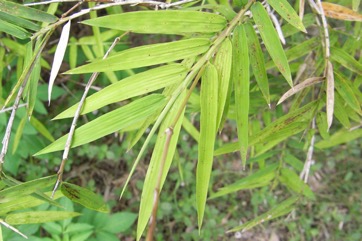
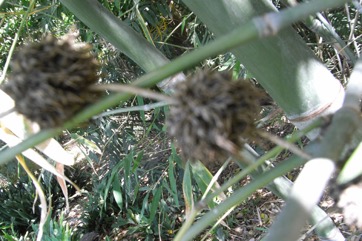
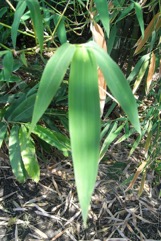
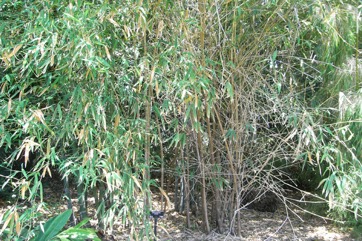
References
Abbiw, D.K., 1990, Useful Plants of Ghana. West African uses of wild and cultivated plants. Intermediate Technology Publications and the Royal Botanic Gardens, Kew. p 42
Ambasta, S.P. (Ed.), 2000, The Useful Plants of India. CSIR India. p 166
Anderson, E. F., 1993, Plants and people of the Golden Triangle. Dioscorides Press. p 209
Bandyopadhyay, S. et al, 2009, Wild edible plants of Koch Bihar district, West Bengal. Natural Products Radiance 8(1) 64-72
Behera K. K., et al, 2008, Wild Edible Plants of Mayurbhanj District, Orissa, India. J. Econ. Taxon. Bot. Vol. 32 (Suppl.) pp 305-314
Bhogaonkar, P. Y. & Devarkar, V. D., 2018, Inventory for ethnovegetable knowledge of the tribals of Satpura hill area-Melghat, Dist. Amravati (India), Plantae Scientia, 2018; Vol. 01 Issue 01: 01-08
Bodkin, F., 1991, Encyclopedia Botanica. Cornstalk publishing, p 335
Burkill, I.H., 1966, A Dictionary of the Economic Products of the Malay Peninsula. Ministry of Agriculture and Cooperatives, Kuala Lumpur, Malaysia. Vol 1 (A-H) p 794
Chandrakumar, P., et al, 2015, Ethnobotanical studies of wild edible plants of Gond, Halba and Kawar tribes of Salekasa Taluka, Gondia District, Maharashtra State, India. International Research Journal of Pharmacy 6(8)
Dangol, D. R. et al, 2017, Wild Edible Plants in Nepal. Proceedings of 2nd National Workshop on CUAOGR, 2017.
Dey, A. & Mukhererjee, A., 2015, Living and Survival Amidst Hunger: Wild Edible Botanicals as a Prime Forest Productivity in the Rural Purulia District, West Bengal, India from Colonial to Present. Research Journal of Forestry 9(3): 71-86
Dobriyal, M. J. R. & Dobriyal, R., 2014, Non Wood Forest Produce an Option for Ethnic Food and Nutritional Security in India. Int. J. of Usuf. Mngt. 15(1):17-37
Dransfield, S. & Widjaja, EA., 1995, Plant Resources of South East Asia. PROSEA No. 7 Bamboos. Leiden. p 93
Facciola, S., 1998, Cornucopia 2: a Source Book of Edible Plants. Kampong Publications, p 46
Hibbert, M., 2002, The Aussie Plant Finder 2002, Florilegium. p 84
http://www.plantnames.unimelb.edu.au/sorting/Bamboos_Edible.html
Jadhav, R., et al, 2015, Forest Foods of Northern Western Ghats: Mode of Consumption, Nutrition and Availability. Asian Agri-History Vol. 19, No. 4: 293-317
Joshi, N., et al, 2007, Traditional neglected vegetables of Nepal: Their sustainable utilization for meeting human needs. Tropentag 2007. Conference on International Agricultural Research for Development.
Kar, A., et al, 2013, Wild Edible Plant Resources used by the Mizos of Mizoram, India. Kathmandu University Journal of Science, Engineering and Technology. Vol. 9, No. 1, July, 2013, 106-126
Khan, M. & Hussain, S., 2014, Diversity of wild edible plants and flowering phenology of district Poonch (J & K) in the northwest Himalaya. Indian Journal of Sci, Res. 9(1): 032-038
LAL et al,
Linnaea 9:476. 1834
Maheshwari, J.K., & Singh, J.P., 1984, Contribution to the Ethnobotany of Bhoxa Tribe of Bijnor and Pauri Garhwal Districts, U.P. J. Econ. Tax. Bot. Vol.5. No.2 pp 253-
Manandhar, N.P., 2002, Plants and People of Nepal. Timber Press. Portland, Oregon. p 194
Menninger, E.A., 1977, Edible Nuts of the World. Horticultural Books. Florida p 147
Mishra, S. & Chaudhury, S. S., 2012, Ethnobotanical flora used by four major tribes of Koraput, Odisha, India. Genetic Resources Crop Evolution 59:793-804
Pandy, R. K. & Saini, S. K., 2007, Edible plants of tropical forests among tribal communities of Madhya Pradesh. Indian Journal of Traditional Knowledge. 6(1), pp 185-190
Pradhan, R., et al, 2020, Potential Wild Edible Plants and its Significance in Livelihood of Indigenous People of Male Mahadeshwara Hills, Karnataka. Economic Affairs Vol. 64, No. 4 pp. 01-14
Prafulla, S., 2017, Wild Food Diversity of Nawegaon-Nagzira Tiger Reserve in Gondia-Bhandara district of Maharashtra, India. Int. J. of Life Sciences, 2017, Vol. 5 (4): 620-626
Prashanth Kumar, G.M. and Shiddamallayya, N., 2015, Ethnobotanical Study of Less Known Wild Edible Plants of Hakki Pikki Tribes of Angadihalli, Hassan District, Karnataka. Journal or Medicinal Plants Studies 3(5):80-85
PROSEA (Plant Resources of South East Asia) handbook, Volume 2, 1991, Edible fruits and nuts.
Purseglove, J.W., 1972, Tropical Crops. Monocotyledons. Longmans p 133
Radha, B., et al, 2013, Wild Edible Plant Resources of the Lohba Range of Kedarnath Forest Division (KFD), Garhwal Himalaya, India. Int. Res J. Biological Sci. Vol. 2 (11), 65-73
Ray, A., et al, 2020, How many Wild Edible Plants do we Use. Frontiers in Sustainable Food Systems. 4:56 p 12
Reddy, B. M., 2012, Wild edible plants of Chandrapur district, Maharashtra, India. Indian Journal of Natural Products and Resources. 3(1) pp 110-117
Reddy, K. N. et al, 2007, Traditional knowledge on wild food plants in Andhra Pradesh. Indian Journal of Traditional Knowledge. Vol. 6(1): 223-229
Rijal, A., 2011, Surviving on Knowledge: Ethnobotany of Chepang community from mid-hills of Nepal. Ethnobotany Research & Applications 9:181-215
Sahni, K.C., 2000, The Book of Indian Trees. Bombay Natural History Society. Oxford. p 189
Saidulu, P. et al, 2015, Ethnobotanical Knowledge Studied in Pocharam Wildlife Sanctuary, Telangana, India. Not Sci Biol, 2015, 7(2):164 -170
Setiya, A. V., et al, 2016, Exploration and documentation of some wild edible plants used by the aboriginals from Gadchiroli District (M.S.) India. International Advanced Research Journal in Science, Engineering and Technology. 3(7)
Singh, H.B., Arora R.K.,1978, Wild edible Plants of India. Indian Council of Agricultural Research, New Delhi. p 84
Singh, V. and Singh, P., 1981, Edible Wild Plants of Eastern Rajasthan. J. Econ. Tax. Bot. Vol 2 pp 197-207
Srichaiwong, P., et al, 2014, A Study of the Biodiversity of Natural Food Production to Support Community Upstream of Chi Basin, Thailand. Asian Social Science 10 (2):
Sukarya, D. G., (Ed.) 2013, 3,500 Plant Species of the Botanic Gardens of Indonesia. LIPI p 841
Toppo, P. et al, 2016, Wild edible plants of Dhamtari district of Chhattisgarh, India. Van Sangyan Vol. 3, No. 4
USDA, ARS, National Genetic Resources Program. Germplasm Resources Information Network - (GRIN). [Online Database] National Germplasm Resources Laboratory, Beltsville, Maryland. Available: www.ars-grin.gov/cgi-bin/npgs/html/econ.pl (10 April 2000)
WATT,
Wild edible plants of Himachal Pradesh
World Checklist of Useful Plant Species 2020. Royal Botanic Gardens, Kew
Yadav, D. K., 2011, Study on Biodiversity and Edible Bioresources of Betla National Park, Palamu, Jharkhand (India). The 2011 Las Vegas International Academic Conference.